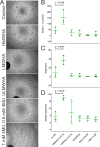Hyaluronan Derived From the Limbus is a Key Regulator of Corneal Lymphangiogenesis
- PMID: 30897620
- PMCID: PMC6432804
- DOI: 10.1167/iovs.18-25920
Hyaluronan Derived From the Limbus is a Key Regulator of Corneal Lymphangiogenesis
Abstract
Purpose: We recently reported that the glycosaminoglycan hyaluronan (HA), which promotes inflammatory angiogenesis in other vascular beds, is an abundant component of the limbal extracellular matrix. Consequently, we have explored the possibility that HA contributes to lymphangiogenesis in the inflamed cornea.
Methods: To study the role of HA on lymphangiogenesis, we used mice lacking the hyaluronan synthases and injury models that induce lymphangiogenesis.
Results: Here we report that HA regulates corneal lymphangiogenesis, both during post-natal development and in response to adult corneal injury. Furthermore, we show that injury to the cornea by alkali burn upregulates both HA production and lymphangiogenesis and that these processes are ablated in HA synthase 2 deficient mice.
Conclusion: These findings raise the possibility that therapeutic blockade of HA-mediated lymphangiogenesis might prevent the corneal scarring and rejection that frequently results from corneal transplantation.
Figures









Similar articles
-
Hyaluronan Rich Microenvironment in the Limbal Stem Cell Niche Regulates Limbal Stem Cell Differentiation.Invest Ophthalmol Vis Sci. 2017 Sep 1;58(11):4407-4421. doi: 10.1167/iovs.17-22326. Invest Ophthalmol Vis Sci. 2017. PMID: 28863216 Free PMC article.
-
Lymphatic vessels correlate closely with inflammation index in alkali burned cornea.Curr Eye Res. 2010 Aug;35(8):685-97. doi: 10.3109/02713681003793136. Curr Eye Res. 2010. PMID: 20673045
-
Long term observation of ocular surface alkali burn in rabbit models: Quantitative analysis of corneal haze, vascularity and self-recovery.Exp Eye Res. 2021 Apr;205:108526. doi: 10.1016/j.exer.2021.108526. Epub 2021 Mar 2. Exp Eye Res. 2021. PMID: 33662355
-
HC-HA/PTX3 Purified From Amniotic Membrane as Novel Regenerative Matrix: Insight Into Relationship Between Inflammation and Regeneration.Invest Ophthalmol Vis Sci. 2016 Apr 1;57(5):ORSFh1-8. doi: 10.1167/iovs.15-17637. Invest Ophthalmol Vis Sci. 2016. PMID: 27116665 Free PMC article. Review.
-
Hyaluronan-Based Hydrogel Scaffolds for Limbal Stem Cell Transplantation: A Review.Cells. 2019 Mar 14;8(3):245. doi: 10.3390/cells8030245. Cells. 2019. PMID: 30875861 Free PMC article. Review.
Cited by
-
Posterior corneoscleral limbus: Architecture, stem cells, and clinical implications.Prog Retin Eye Res. 2023 Sep;96:101192. doi: 10.1016/j.preteyeres.2023.101192. Epub 2023 Jun 29. Prog Retin Eye Res. 2023. PMID: 37392960 Free PMC article. Review.
-
Age-Related Differences in the Mouse Corneal Epithelial Transcriptome and Their Impact on Corneal Wound Healing.Invest Ophthalmol Vis Sci. 2024 May 1;65(5):21. doi: 10.1167/iovs.65.5.21. Invest Ophthalmol Vis Sci. 2024. PMID: 38739085 Free PMC article.
-
Development of Biomimetic Substrates for Limbal Epithelial Stem Cells Using Collagen-Based Films, Hyaluronic Acid, Immortalized Cells, and Macromolecular Crowding.Life (Basel). 2024 Nov 26;14(12):1552. doi: 10.3390/life14121552. Life (Basel). 2024. PMID: 39768260 Free PMC article.
-
The Potential Reversible Transition between Stem Cells and Transient-Amplifying Cells: The Limbal Epithelial Stem Cell Perspective.Cells. 2024 Apr 25;13(9):748. doi: 10.3390/cells13090748. Cells. 2024. PMID: 38727284 Free PMC article. Review.
-
Distribution and Function of Glycosaminoglycans and Proteoglycans in the Development, Homeostasis and Pathology of the Ocular Surface.Front Cell Dev Biol. 2020 Aug 7;8:731. doi: 10.3389/fcell.2020.00731. eCollection 2020. Front Cell Dev Biol. 2020. PMID: 32903857 Free PMC article. Review.
References
-
- Brown P. Lymphatic system: unlocking the drains. Nature. 2005;436:456–458. - PubMed
-
- Hos D, Bachmann B, Bock F, Onderka J, Cursiefen C. Age-related changes in murine limbal lymphatic vessels and corneal lymphangiogenesis. Exp Eye Res. 2008;87:427–432. - PubMed
-
- Van Buskirk EM. The anatomy of the limbus. Eye (Lond) 1989;3(Pt 2):101–108. - PubMed
Publication types
MeSH terms
Substances
Grants and funding
LinkOut - more resources
Full Text Sources
Molecular Biology Databases

